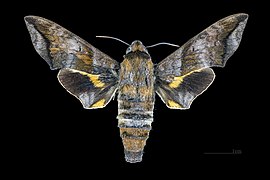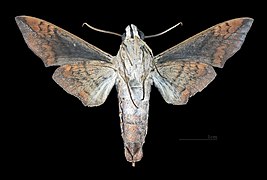Perigonia lusca
| Half-blind sphinx | |
|---|---|

| |
| Scientific classification | |
| Domain: | Eukaryota |
| Kingdom: | Animalia |
| Phylum: | Arthropoda |
| Class: | Insecta |
| Order: | Lepidoptera |
| Family: | Sphingidae |
| Genus: | Perigonia |
| Species: | P. lusca
|
| Binomial name | |
| Perigonia lusca | |
| Synonyms | |
Perigonia lusca, the half-blind sphinx or coffee sphinx, is a moth of the family Sphingidae. It was first described by Johan Christian Fabricius in 1777.
Distribution[edit]
It is found from the northern tip of South America, through most of Central America, and up to Florida in the United States.[2]
Description[edit]
The wingspan is 55–65 mm.
-
Male dorsal view
-
Male ventral view
-
Female dorsal view
-
Female ventral view
Biology[edit]
There are several generations per year in southern Florida. On the Galápagos Islands, adults are on wing in April and July. In the tropics, adults are probably on wing year round.
The larvae have been recorded feeding on Guettarda macrosperma, Guettarda scabra, Coffea species (including Coffea arabica), Ilex krugiana, Ilex paraguariensis, Genipa americana, Rondeletia, Gonzalagunia species (including Gonzalagunia spicata) and Cinchona succirubra. They are green with a yellow tail horn and a dark blue stripe down the back. There is at least one color morph.
Subspecies and formes[edit]
- Perigonia lusca lusca (Mexico to Panama and Honduras, Venezuela, Paraguay, Argentina, Brazil, Bolivia, Bahamas, Cuba, Puerto Rico, St. Vincent, southern United States)
- Perigonia lusca continua Vázquez-G., 1959 (Revillagigedo Island and Soccoro Island in Mexico)
- Perigonia lusca f. interrupta Walker, 1875
-
Perigonia lusca f. interrupta
Male dorsal view -
Perigonia lusca f. interrupta
Male ventral view -
Perigonia lusca f. interrupta
Female dorsal view -
Perigonia lusca f. interrupta
Female ventral view
References[edit]
- ^ "CATE Creating a Taxonomic eScience – Sphingidae". Cate-sphingidae.org. Archived from the original on 12 November 2012. Retrieved 19 October 2011.
- ^ "Perigonia lusca". Silkmoths. Archived from the original on 12 May 2013. Retrieved 19 October 2011.
External links[edit]
- Lotts, Kelly & Naberhaus, Thomas (2017). "Half-blind sphinx Perigonia lusca (Fabricius, 1777)". Butterflies and Moths of North America. Retrieved 21 November 2018.








